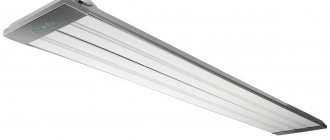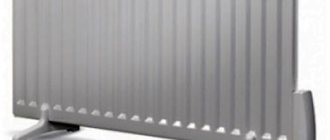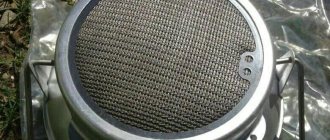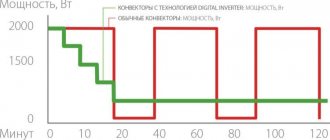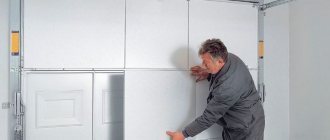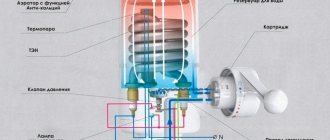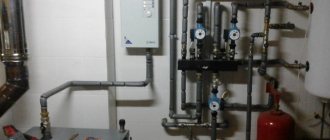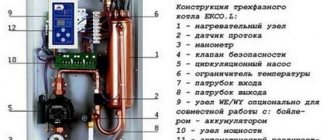Simplicity of design and advantages
From the description, it’s easy to guess that the discussion will be about how effective quartz heaters are for the home and whether their use is beneficial in practice.
In fact, at first glance, the primitive design of a quartz heating device is fraught with a lot of advantages: the heating element, made of an alloy of chromium and nickel, is completely covered with a solid quartz plate. When the device is turned on, its temperature cannot rise higher than +95 degrees. This completely eliminates the possibility of ignition of objects or flammable materials located near it.
The second advantage is that at this temperature, dust does not burn and does not dry out the air in the room; it remains fresh and quite suitable for normal human life.
The closed design of the heating device allows you to maximize the service life of the element itself - the absence of air access prevents the onset of oxidative processes.
The monolithic quartz slab releases the heat accumulated during operation over a fairly long period of time, while heating the room quite effectively. The operation of a quartz heater can continue for a long time - since its operating temperature is not high, and it rises in about twenty minutes.
To control the quartz heater, manual and automatic systems are provided, the operation of which will require connecting an air thermostat.
Despite the additional costs, when using an automated system, the user receives the opportunity for significant savings - the device will only work if it is necessary to increase the air temperature in the room. The electricity consumption of the heater is about 0.5 kW/h, which is much less than radiators or oil convectors.
Installation diagram of quartz heaters
How to choose?
WATCH THE VIDEO
Let's figure out what to look for when choosing a quartz heating device:
As when purchasing other household appliances, the first thing people pay attention to is the manufacturer of the product. Do not buy electrical appliances of dubious quality, without the appropriate technical documentation and certificates - such products are a fire hazard. The second danger of low-quality heaters is not so obvious, but no less dangerous.
Handicraft products use materials that are not intended for use at high temperatures. When heated, such materials release compounds harmful to human health, which over time will lead to the development of diseases. It is better to choose a heater equipped with a thermostat. A thermostat for an infrared heater will save up to half of your electricity. If the device is not equipped with sensors, the thermostat for the infrared heater is purchased separately. Even when choosing products from a well-known manufacturer, the buyer is not immune from counterfeits. Therefore, carefully inspect the device before purchasing. The body should be free of dents and rust. Heating elements: emitters or quartz plates must not have stains or streaks on the surface. The following signs will tell the buyer that the product is of poor quality: lack of casings and lugs on the wires; terminal blocks made of polyamide rather than ceramic or fiberglass; The foil of the IR emitter reflector is thin and breaks through when pressed with a finger or a ballpoint pen. Pay attention to the technical documentation. The product must have domestic quality certificates and a hygienic certificate. If the seller does not have these documents, it is better to refuse the questionable purchase.
INSTALLATION, SAVINGS AND ENERGY SAVING
The most common is wall-mounted heater installation. The heating plate is located at a distance of about 10 centimeters from the wall, on the surface of which a heat-reflecting screen made of foil material is installed, which increases the energy efficiency of the heater.
The quartz wall heater has dual action. During operation, its monolithic body heats up to a temperature reaching 90°C. Such significant heating turns the quartz slab into a source of intense infrared radiation.
On the other hand, a significant surface area of the heated body carries out active convective heat exchange with the surrounding air.
That is, the heater works simultaneously as an infrared and as a convector heat source. Therefore, in order to effectively use the convective properties of the heater, it is usually installed low from the floor - just like water heating radiators.
You can often hear about the high energy-saving properties of electric heaters of one type or another. All heaters using electrical energy have almost the same, fairly high efficiency, which does not depend on their design. Efficiency characterizes the process of converting electrical energy into heat, which occurs according to the Joule-Lenz law.
You should not trust claims that you can use less electricity to heat the same room just by choosing a certain type of electric heater.
Savings can be achieved using only electric heating by implementing the following measures:
- rational location of heaters in a heated room, taking into account their technical characteristics and design;
- application of automatic control means.
The energy-saving effect when using electric heaters is achieved through means of regulating and controlling their operation.
However, design features affect the operation of electric heaters. Let's try to formulate the pros and cons of quartz versions.
The design of these devices provides a number of advantages:
- the absence of direct contact of the heating elements with the room air significantly extends their service life, the quality of the air itself does not deteriorate due to the combustion of oxygen by a hot spiral;
- hermetic design ensures increased fire safety of the premises;
- the flat surfaces of a monolithic quartz slab have a significantly larger heat exchange area than the heating element itself used in the design;
- the presence of an infrared component of the energy exchange process gives the devices all the advantages of heat sources of this type;
- The simplicity of the heater determines its high reliability and durability.
However, simplification also has a downside. The lack of built-in regulators or thermostats forces you to purchase them separately to organize energy-saving heating, which requires extra costs. High surface heating can also pose a danger to children.
How to choose the right heater
There are a lot of household quartz heaters. The characteristics of the varied assortment vary greatly. There are options for small portable models. There are floor-standing devices. There are dimensional varieties for permanent installation on the ceiling. There are very few wall-mounted models and it is not recommended to purchase them, since in this case the flow of light energy is directed strictly in one direction and “blind” zones are created where heat does not reach.
Quartz heaters should not be confused with medical quartz lamps. Heaters do not bring any benefit to humans, nor do they cause harm (or rather, to the vast majority of people). Lamps used in medicine for quartz treatment create a stream of ultraviolet radiation, which kills harmful microorganisms.
But you should take into account the fact that some people have a sensitivity to infrared radiation, even to the point of allergies. The eyes become uncomfortable, the nose begins to itch.
Quartz heater: pros and cons
When choosing, you need to consider the following general points:
- Ten. Must be protected by a housing.
- Frame. Must have a high-quality coating.
- Reflective element. It is not required to perform decorative functions or heat the ceiling, but to reflect the rays onto objects.
- Insulator. Should protect against overheating. This is the most important part of the device.
All infrared quartz devices heat up the glass tube very much - up to seven hundred degrees. On the one hand, this allows you to raise the temperature in the room almost instantly. On the other hand, safety rules must be followed. In addition, small particles of dust, which are always and everywhere, fall on the heated glass of the device. They burn on a hot glass tube, releasing a characteristic odor.
https://youtube.com/watch?v=gJ0olkM_EtU
The devices are afraid of humidity, as a result of which they are short-lived. The average service life of infrared heaters is about two years. They require careful handling as they are very fragile. If the glass tube is damaged, it is more advisable to buy a new device than to replace the old one: the cost will be approximately the same.
The devices can consist of several tubes, which increases the heating power. Quartz infrared devices are small in size - many of them can easily fit under a table.
It is very convenient to use heaters of this type in cases where you need to warm up an area of the territory, and not the entire room. For example, in a garage when working under a car or in a workshop behind a workplace.
Perfect for a short visit to a summer cottage, under any conditions outside the city, when there is no need to install a stationary heating system. Given the compactness of the device, you can simply bring it with you.
Thanks to the directed energy flow, they can be placed directly on the street. For example, in places of relaxation, walks or in open-air cafes. Some models are equipped with remote controls. The device operates silently with almost 100% efficiency.
The power range varies from 800 W to 3 kW. When calculating and choosing an infrared heater, you can use the average formula: for 10 square meters - 1 kW of power.
Monolithic or infrared?
If there is a choice about which heating system to install, then you must first decide whether the system will be completely autonomous or not? If you need constant and long-term heating, then you should choose monolithic quartz heaters.
When deciding on the issue of periodically heating a room during temporary shutdowns of the main heating system, you need to purchase an infrared model of the device. If you need to warm up very quickly, then the choice is also in favor of the infrared model.
If you need to constantly heat the room, then a monolithic heater will help with this.
Whatever device is ultimately chosen, each type of quartz heater copes with its tasks perfectly. Whether it is quartz wall-mounted energy-saving heaters for the home or floor-mounted monolithic heaters, or infrared tubular devices - they all bring warmth and good mood to the house.
Design of monolithic heaters
Monolithic heater design
The design of quartz heating panels is simple.
The device includes:
- heating element - nichrome insulated wire with resistance adjusted to the required power;
- a panel made of a mixture of quartz sand and kaolin white clay, in which the heating element is embedded;
- metal frame-case to protect the panel from damage;
- stand for floor mounting or brackets for wall mounting;
- power cord with plug.
Some models have a built-in temperature controller; for others, the device is purchased for an additional fee.
Principle of operation
The ceramic heater operates on the principle of forced convection and infrared radiation. Therefore, it is not strange that manufacturers began to talk about “the miracle of technological thought.” For example, here are a few advantages that the manufacturer claims:
- Doesn’t dry the air at all – a blatant lie! Any heat source dries the air, even if we are talking about a heating radiator, which often does not heat above 80 degrees;
- service life is 30 years - what can work for so long? The wiring is designed to last 15 years, any heating element wears out after three years, the housing is constantly overheating and cooling. Well, we don’t understand how it will serve for such a period of time;
- safety of - what, an electrical device? Any electrical parting is dangerous. Another thing is how well the protection is thought out and what materials it is made of. There is only a safety class, nothing is absolute, even clean water can be hazardous to health;
- high efficiency - possible, but we will argue with this further;
- doesn’t raise dust - what should raise it? It's not at all clear here;
- useful infrared radiation - there is still a huge amount of controversy about this. IR radiation cannot be called safe, especially if it interacts with the skin, since it seriously dries it out and causes irritation;
- saving electricity up to 35% - but here there are a lot of questions. Again, which has not been proven in any way.
As you may have noticed, there are not many real advantages, so talking about “miracle technology” makes no sense. But there’s nothing bad about them either; later we’ll remember the main advantages.
Monolithic quartz heater: characteristics
Such a monolithic air heater in a wooden house or country house consists of modules connected in parallel. The basic equipment also includes equipment for regulating air temperature.

Such heaters can be installed both on the floor and on the wall, and they are completely fireproof. Now let's look at all the pros and cons of this type of heating apparatus. As for the negative properties, we can safely say that no disadvantages were noticed in this electric heating device, even after numerous diverse checks and experiments.
Pros:
- High heat capacity.
- Manufacturers guarantee that the electrical heating device will last a long time, and all this time it will reliably heat the house.
- Since the principle of operation is based on a simple scheme, which consists in the direct conversion of electrical energy into heat, there is no doubt that exactly as much electricity will be spent as is needed to heat the room.
- According to experts, one average monolithic quartz heater can easily heat a room whose volume does not exceed 15-16 m3.
- A unique alloy using quartz sand allows the device to radiate heat for a long time even after being disconnected from the network.
- Safety in use is explained by the fact that quartz monolithic heaters cannot heat above 90-95 ᵒC;
A special case of monolithic heating devices is a quartz battery, which also has numerous positive reviews from both specialists and the general population.
Quartz IR heaters
Infrared heaters are economical and easy-to-use devices that will allow you to evenly warm up a room in a short time. Heating is carried out using directed IR rays, so it does not take time to warm up the device itself.
Due to their light weight, IR heaters can be placed not only on the floor or walls, but also on ceilings. A ceiling-mounted infrared heater for a summer residence will allow you to heat up an unheated room in a matter of minutes. A Tepleko quartz heater or a Peony heater is suitable for placement on the ceiling.
When choosing an infrared heater for your dacha, opt for models with thermostats; they will allow you to maintain a constant temperature even in your absence. If temperature sensors for heaters are not included in the kit, they must be purchased separately. There are usually no problems when installing the sensor, since the diagram for connecting the thermostat to the infrared heater is simple and can be easily found on the Internet.
Quartz IR heaters - powerful and reliable devices
Like any household appliance, IR emitters have advantages and disadvantages. The advantages include the following properties:
- They are economical; in terms of the amount of electricity consumed, although these devices are inferior to monolithic quartz heaters, they are much superior to convectors, fan heaters and fireplaces.
- When chosen correctly, they are durable. A high-quality product from a reputable manufacturer will last a long time, and its operation is safe for others.
The disadvantages of infrared quartz emitters are as follows:
- Radiation travels in a straight line and, upon reaching an object, heats it. That is, if there are many obstacles in the path of the emitter, the waves will not reach the area where heating is necessary. At the same time, the device is not recommended to be placed directly near people, since its effect on the human body has not been fully studied. The best option is an IR ceiling heater with a thermostat. It is located at a sufficient distance from the surface, and its rays do not encounter any obstacles in their path.
- The heating elements of quartz emitters heat up to a high temperature. If there are children in the house, the device must be raised to a sufficient height.
- IR emitters consume a lot of electricity. If you use such a device constantly, this will affect the amount of payment for electricity.
Monolithic quartz heaters
This type of quartz infrared heaters differs from lamp heaters in design and manufacturing technology; to shorten the name of the type, the abbreviation MKTEN is used - monolithic quartz thermal-electric heater.
The device is manufactured as follows. First, a heating element is made - a metal tube bent like a snake with sealed ends, into which a nichrome spiral is placed and quartz sand is poured. The ends of the spiral are brought out from the ends of the tube in the form of contacts.
This “snake” tube is placed flat into a flat mold of given dimensions with the contacts of the nichrome thread extending beyond its walls, after which the mold is filled with a plastic mixture of quartz sand with marble chips based on a binder - white clay. The contents of the mold are compacted and sent to the oven for drying, resulting in a flat monolithic decorative panel made of artificial stone with a heating element inside, evenly heated when electricity passes through a nichrome thread and releases heat to the environment through the convection effect.
When molding slabs, technologies are used that make it possible to create aesthetically attractive panels that fit into the existing interior of the room. When purchasing such a heater, the dimensions and power are selected based on the individual needs of the consumer.
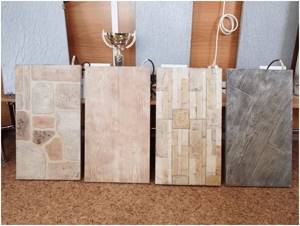
For ease of use and automatic maintenance of the room temperature, many of these heaters are equipped with a thermostat. If the standard configuration of the device does not include a thermostat, then it is technically possible to install it additionally on the device.
In terms of efficiency, a monolithic quartz heater is significantly superior to lamp heaters - for heating 16 - 17 sq. m. area during the day, a monolithic device consumes approximately 0.5 kW of electricity.
Types of monolithic heaters by design
A monolithic quartz heater can also be portable or permanently mounted on a base.
Portable panels, despite their significant weight (10 - 12 kg), are easily moved thanks to the wheels included in the design. In this case, the weight of the device is not a disadvantage - the unit is more difficult to tip over.
The standard size of the slab is 610x340x25 mm, which does not create problems when moving between rooms even in small apartments.
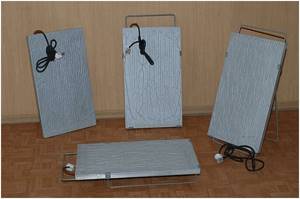
Installing MKTEN on a wall is usually not technically difficult if you follow the instructions for installing the device. But for safety reasons, attaching such a unit to the ceiling should be avoided, since the significant weight of the device places increased demands on the fastening and load-bearing characteristics of the base, an error in which can result in the device falling and causing injury.

Advantages and disadvantages of monolithic quartz heating elements
The list of positive characteristics of monolithic heating panels is much wider than that of lamp heaters. To make the right choice when purchasing a device, we list these advantages:
- efficiency;
- thermal safety (maximum panel temperature +95 degrees);
- ease of daily care;
- resistance to mechanical damage;
- compactness;
- sustainability;
- aesthetics;
- no harm to health when used;
- affordability;
- large selection of artistic solutions.
However, MKTEN also has disadvantages:
- lack of autonomy;
- impossibility of repairing or replacing heating elements;
- dustiness accompanying convection in certain areas of the room.
The list of negatives is very modest, which is even more surprising after reading the really low prices.
Quartz heater: reviews and selection of the optimal device
The current market is oversaturated with a variety of heating devices. Quartz designs stand out from the total mass of heaters due to their practicality. They have a lot of advantages, although, like many other products, they are not without drawbacks.
Quartz heating devices are considered to be electric heating equipment that partially contains quartz. Some structural elements are made from this mineral. Depending on the type of device and its modification, quartz can contain completely different elements.

Different types of heating devices contain quartz in completely different design elements
Operating principle of a quartz sand heater
Each type of quartz device used to heat a home has its own operating principle. But this principle is based on the same scheme of action: the temperature of the heating element increases due to particles of electricity that pass through it, causing high resistance.
There are two types of quartz structures on the market: infrared and monolithic. According to the principle of operation, quartz devices are also divided into two types: inductive and resistive. A distinctive feature of the latter is the absence of magnetic fields that have a negative effect on the human body. In addition, such heaters do not contribute to the heating of metal fittings on clothing (buttons, zippers). This usually becomes a problem if you inadvertently get too close to a working device.
Thanks to modern technologies, electrical energy costs can be reduced. There are many ways to use electricity economically for heating while maximizing the benefits of this energy.

A quartz heater can be turned into an art object that will become a decoration and highlight of the interior
For a quartz device, it is recommended to purchase a temperature sensor with an automatic control system. The sensor reacts to temperature changes in the room and is triggered, turning the equipment on or off depending on the settings that you can set yourself. This scheme allows you to reduce costs by 1/3.
Construction of a monolithic quartz heater
The monolithic design option (MKTEN) has another name - tiled. In production, its production is carried out according to the following scheme:
- Preparation of a solution, which contains marble chips (crushed dolomite), white kaolin clay and quartz sand in different proportions.
- Pouring the mixture into flat molds on top of a nichrome spiral. This material is a metal alloy of chromium and nickel.
- Compound compaction.
- Drying procedure.
- Sintering of the product.
In its finished form, the device is a kind of equivalent to the design of an oil heater, only dry. When the device is connected to the mains, the nichrome spiral heats up. Following this, the entire stove heats up.

Monolithic quartz construction not only heats the air in the room, but also accumulates heat
Infrared quartz heater device for home
Infrared designs of quartz devices are equipped with a heat-emitting element in the form of a tungsten spiral. It is in a glass tube. A glass flask is a preventive measure to prevent the appearance of an unpleasant odor. The spiral, made of tungsten, becomes red-hot. If it were not for the glass tube, dust particles falling on the coil would constantly burn, filling the room with an unpleasant odor.
It is most advisable to use infrared type of equipment for fixed heating. It is best to install such a device in the living room, where there is a TV, or near the workplace. Of course, the room will not warm up completely, but you can achieve significant electricity savings by purchasing a unit with a low power level.
The most significant advantage of such a device is comfortable operation. The design is compact, mobile, and in the process of releasing heat, the air in the room does not burn, as is usually the case with convection products that require the purchase of air humidifiers. In this case, the natural humidity of the room is maintained, so that even after the room has been warmed up for a long time, people can still breathe easily.
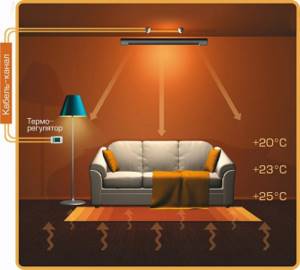
Operating principle of pendant-type infrared quartz heater
Which heaters are better: infrared or quartz monolithic designs
Infrared heaters can have four types of heating element: quartz, halogen, ceramic or micathermic. Each of them has its own advantages and disadvantages, but the principle of operation is the same. Therefore, we will further consider the features of infrared devices with a quartz heating element and quartz monolithic structures.
Despite the many advantages that unite these devices, each of them heats the room in its own way. For this reason, heaters must be selected taking into account your own needs and room conditions:
- its size;
- air temperature;
- the presence or absence of good insulation.
The monolithic unit heats the room using the convection effect. During this, a gradual increase in air temperature occurs in all points of the room. When air is heated, it expands and its density decreases, so it rises. The monolithic heater first heats the air layer opposite itself, after which each subsequent layer is heated by raising hot flows upward.
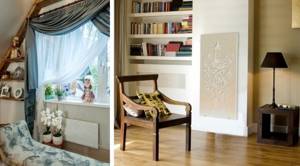
Monolithic quartz heating structures in the home interior
The operation of an infrared heater does not involve the use of convection. In the process of heating a room, thermal radiation is intensively transmitted, which has a directional distribution. Heat is not dissipated throughout the room due to the fact that the device is equipped with a focusing reflector that reflects it in the desired direction.
Thermal radiation is generated by a quartz flask, inside of which a spiral is sealed. In this case, the objects in front of the structure are heated, not the air. In other words, the lamp will heat people and things located directly in front of it in the radiation zone.
The best device is determined based on whether the buyer requires uniform heating of the room or locally directed heat.
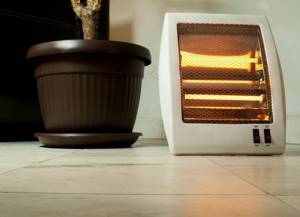
Infrared heaters have a directional effect
Monolithic or infrared quartz heater: which is better to choose?
Infrared devices will be useful in rooms where there is no proper thermal insulation. For insulated rooms with minimal heat losses, it is better to take monolithic heaters. When the operating conditions of the room have been determined, you can proceed to comparing the characteristics of these units.
In terms of weight, monolithic structures are significantly inferior to infrared devices. Their weight is 10-12 kg. But tiled heaters are very compact. Standard dimensional parameters are 60x35 cm, while the thickness of the structure does not exceed 25 mm. Dimensions of products, depending on the manufacturer, may differ from those indicated, but not significantly.
If a tile unit is purchased to order, many manufacturers give buyers the right to choose the material from which the protective frame will be made. The most budget option is aluminum. The highest quality frames are made of steel coated with a protective coating.

Quartz structures are practical, easy to use and have a high level of safety.
Infrared models are more functional. They allow you to adjust the power level in the range of 1-3 kW. The reflector contains 500 W lamps. The ability to accurately regulate heating depends on their quantity. The main thing is not to overdo it so that the emitter does not harm other people.
Operating a quartz heater: is it harmful?
If we talk about infrared emitters and their harm, it is worth taking a closer look at the temperature capabilities of these units and the degree of effect on humans.
Modern heater designs fall into three categories:
- 300 °C – long-wave emitters that are not capable of causing harm to human health (provided that the rays are not directed at a person at a right angle);
- 600 °C – the wave range practically coincides with the human body;
- 800 °C – units with short-wave action (this type of radiation can be extremely dangerous, since it has the ability to penetrate the skin of the human body).
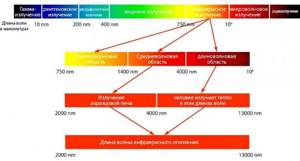
A short stay under infrared radiation is not only harmless, but can also have certain benefits
The degree of harm a quartz heater can cause to health can be compared to the effect of sunlight on a person. In both cases, the thermal component is based on the principle of propagation of waves in the infrared spectrum. In other words, if you are briefly exposed to radiation within 10-20 microns, your health will not be harmed. Rather, on the contrary, the body is toned.
It is better to avoid staying under an infrared heater for a long time, as this can lead to burns on the skin.
Price of quartz heaters TeploEko, TeploPlit and Texture
Monolithic structures are characterized by long service lives (up to 25 years). Moreover, this period of operation is accompanied by a minimum number of breakdowns. As a rule, the main part of the breakdowns occurs in the power cord, which is very easy to replace if necessary.

Monolithic quartz construction is most often used for heating country houses and cottages.
Now you can calculate the amount of electrical energy required for one unit for the heating season: 1800 h x 0.4 kW = 720 kW/h.
Taking into account the fact that you will need 6 appliances to heat the house, and the cost of 1 kW is 2 rubles. you can easily calculate what the total costs will be: 720 kW/h x 6 (heaters) x 2 rubles. = 8640 rub. in year.
Average price of monolithic quartz heaters for home:
| Brand | power, kWt | Dimensions, cm | Action area, m | price, rub. |
| TepplEco | 0,4 | 2.5x35x60 | 8-10 | 2300-2600 |
| TeploPlit | 0,45-0,5 | 12 | 2400-3000 | |
| Texture | 0,4 | 10 | 2300-4950 |
Prices depend on the characteristics of a particular model, its design, components and power.
Price of quartz heaters for home with infrared radiation
Most infrared emitters have a floor-mounted design. For convenience, some models are equipped with a stand that adjusts the position of the device in height.
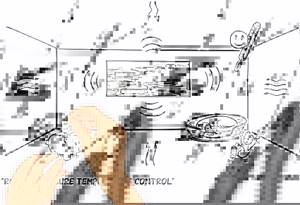
Compared to traditional heating equipment, quartz is characterized by low energy consumption, which allows you to save significant money
Additional advantages of emitters:
- The thermostat ensures high efficiency and cost-effectiveness.
- In case of overheating or overturning of the structure, the device automatically turns off.
- The unit is equipped with a timer that allows you to control the operating time of the device.
- The weight of the product is in the range of 10-12 kg (depending on the material from which the structure is made).
- Surface temperature in operating mode is 95 °C.
- The power consumption level is 400-500 W.
- The operating temperature of the heater is 120 °C.
- The speed at which the device cools is about 1 °C/min.
- The recommended room size is 16-18 m².
- from 300 to 600 °C – length is 2.5-50 microns;
- from 600 to 800 °C – length is 0.7-2.5 microns.
Average prices for infrared quartz emitters:
| Brand | Device model | power, kWt | Dimensions, cm | Action area, m | price, rub. |
| Sinbo | SFH-3310 | 1 | 14x23x43 | 15 | 1300-1400 |
| Noirot | Royat-2 1800 | 1,8 | 11x12x55 | 15 | 8100-8300 |
| Stiebel | Eltron IW 120 | 1,2 | 8.5x14.5x53.5 | 15 | 4200-4500 |
| Prorab | QH 800 | 0,8 | 18x35x47 | 8 | 1000-1500 |
| AEG | IR Premium 6000 | 6 | 110x27x110 | 36 | 145000-147000 |
| Comfort | K-19N | 2 | 18x35x47 | 10 | 1500-2000 |
Comparative characteristics of infrared and monolithic devices
Monolithic models have a standard size, which, depending on the manufacturer, can vary within 1-2 cm.
Main characteristics of heaters with monolithic construction:
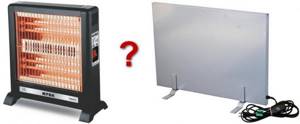
The choice of type of heating structure depends on the room conditions and personal preferences of the buyer
Infrared emitters have a wider range of sizes. Buyers also have significant choice regarding the weight of the structure. These devices have a lightweight body from 1 to 3 kg.
The wavelength depends on the operating temperature of the emitter:
Household models consume from 1 to 3 kW. Several heating elements can be installed in one unit. The power of each of them is 400-500 W.
Operation of quartz heaters: negative and positive reviews
Consumer opinions differ regarding infrared and monolithic structures. Some reviews are positive, others, on the contrary, talk about the shortcomings of certain products.

Quartz infrared heater is a bright accent in the interior of the dining room
Here are some of them:
“Last year I purchased several monolithic heaters for my home. I decided to do this only because I heard on every corner about the merits of these products. But I became disillusioned with them very quickly. This is not to say that they are impractical. And the savings from them are significant. But I didn’t feel any warmth as such in the house. Therefore, I installed some of the monolithic models in the living room, and purchased an infrared heater for the bedroom. Although it acts locally, you don’t have to wait until the whole room warms up.”
Vitaly Andrienko, Ekaterinburg
“When my husband and I were looking for where to buy a quartz heater for our dacha, we spent a lot of time until we decided on a suitable option. We decided on a tile heater. The devices performed excellently. Of course, I had to spend money on a thermostat, but now energy consumption is minimal and completely under control. With such equipment, it’s not scary to leave the dacha for a week. In winter, at an operating temperature of the heater of 10 °C, the house is protected from freezing. I'm very pleased with my purchase."
Tatyana Smirnova, Moscow
“Personally, I prefer infrared heaters. Despite their price, they are completely worth it. Energy consumption is very small. When the central heating system in the apartment does not cope with its task, I simply bring the temperature to the desired level using the heater.”
Igor Skorodko, St. Petersburg
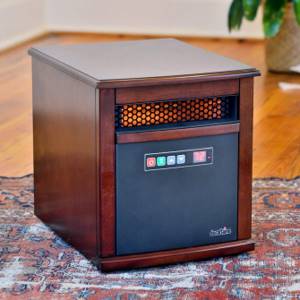
Mobile version of an infrared quartz heater, made in the form of a piece of furniture
Pros of halogen heaters
Halogen heaters have a high efficiency factor. The heat generated is twice as much as the same oil heater produces. The heating wave is up to 4 m, while in others it is only 1 m.
The heating element has no expiration date. You can say it is eternal.
Does not dry out the air and does not burn oxygen. Because it heats objects, not air. And they already give off heat to the air.
Automatic shutdown when voltage drops or surges in the network
This is very important when there are children in the house and when running around, they can catch the heater. The most important thing is savings. Halogen heaters consume much less energy than conventional heaters.
Silence
The device will not disturb with its humming if people are relaxing in the room.
It is not a dirt collector, as it does not attract dust.
The speed at which heat is felt. The heater takes a minimum of time to heat the room.
The principle of directed heat makes it possible to use the heater outdoors. This can be not only the terrace of a private house, but also an open-air cafe. They are also useful for repairs. If you need to dry the plaster on the wall, but there is no heating, it is damp outside, then a directed flow of heat will dry the wall quickly.
Halogen systems are also in demand among farmers. They are placed in barns and chicken coops in severe frosts. If an animal accidentally gets to it and knocks it down, the chain will automatically open. In rooms where there is a lot of hay and straw, this property will help avoid fire.
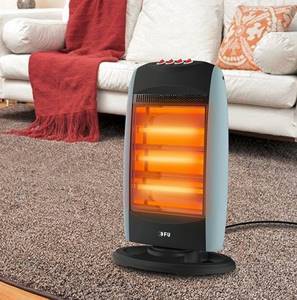
Should I use quartz infrared heaters: disadvantages
Like other types of quartz heaters, infrared radiators are universal in use, economical in terms of energy/heat ratio, and practically durable in terms of duration of use.
It is these emitters that distribute the heat rays of infrared radiation into the room. The basic heater kit also includes a reflector, due to which the housing that surrounds the lamp is protected from overheating.
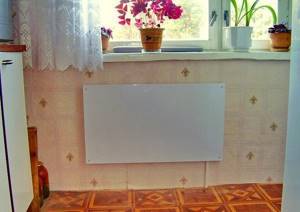
There are some disadvantages:
- The heat flow follows one straight line; everything that goes beyond this line is not heated as intensely.
- Externally it does not look very aesthetically pleasing.
- Do not install in direct access to children.
- For large rooms, 1 quartz infrared heater will not be enough.
And yet, the presence of certain advantages of infrared heaters outweighs the disadvantages, and all manufacturers try to make their products as convenient and safe as possible for use over a long period of time.
Excellent infrared quartz heating devices
Infrared models are very practical, as they allow the device to vary the power within the range from 1 to 3 kW. The reflector contains 500 W lamps. Depending on how many of them are in the device, it becomes possible to precisely regulate the heating.
Polaris PQSH 0208
Quartz heating element does not stop working in 2 modes. Provides greater productivity with relatively low energy consumption. Overheating protection is provided; when tipped over, it turns off immediately.
Polaris PQSH 0208
- power – 0.4 kW, 0.8 kW;
- heating mode – 2;
- recommended area – 20 m2;
- weight – 1 kg.
- normal control with 2 buttons;
- 2 two power modes;
- fire safety shutdown;
- price.
- it can only be used as an additional source; in itself it is rather weak.
DELTA D-018
Recommended for heating large rooms. There are 3 heating modes and 2 power modes, built-in overheating protection and an air humidifier. When tipped over, the device turns off quickly, and overheating protection is also provided.
- power - 2 kW;
- TENOV – 4;
- heating area - 4 m2;
- control - mechanical
- weight - 5 kg.
- good;
- decent infrared ray capture area;
- Suitable for both warehouse and household purposes.
VIDEO: Myths and reality about quartz heaters
pros
High efficiency. Expensive and cheap models generally correspond to the set prices. With reasonable electricity consumption, they heat the room well
It is important to note that all types of modern heaters have this advantage.
Availability. Despite their relative newness on the market, they do not have exorbitant prices
More expensive models have high quality characteristics, control panels, and they can also consume less electricity. Cheap, simpler ones are essentially a simple quartz stove without legs and power regulators, but in terms of heating they are not inferior to expensive ones.
Ease of operation and design. Among the known types of heaters, this one is the simplest both in appearance and in terms of use. You just need to install it and plug it into a power outlet. It does not make noise during operation, which is useful for people working shifts. It can be left running overnight if desired, although this may raise safety concerns.
Good room heating. Quartz models are characterized by a fast rate of room heating. However, only if the apartment or house is insulated. Otherwise, the room heats up quickly and cools down just as quickly. That is, the heater should work almost all the time. But this is not a drawback of the device. It performs its function properly. The appearance of such a heater is universal. It fits into almost any design.
Fireproof. Despite heating the stoves to maximum, they do not burn and are therefore quite safe.
They don't dry out the air. This is probably the most pleasant plus. The eternal problem of winter with dry air has been solved once and for all. This device heats but does not dry the air, making the room warm and pleasant. Due to the fact that air cannot reach the heating element, the latter does not oxidize and the device lasts much longer.
Doesn't burn dust. Many electrical appliances burn dust, leaving behind an unpleasant burning and dry smell. There is no such problem here. Dust is not burned, and the air remains fresh. Automatic devices allow you to save energy. They turn off when the temperature reaches a certain level and turn on again when it drops.
The slab can be painted if desired. Of course, not all models are designed for this, but some can actually be painted. In this case, you need to choose heat-resistant paints that will not deteriorate at high temperatures.

Recommendations for use
Like any electrical device, quartz heaters require strict adherence to operating rules. Let's remember the main ones:
- Before connecting to the outlet, the wiring is inspected. There should be no damage to it;
- turn on and let the device heat up well (the very first turn on) - in production, even with well-known brands, it is not always possible to dry the device well. If this is not done in a timely manner, the reflector may smell unpleasant for a long time, and the panel may experience electric shock or crack;
- You can dry things only with special racks. In their absence, there is a high risk of fire;
- Monolithic batteries must be handled with care - the slab is fragile: any drops or slight impacts can lead to cracking of the quartz;
- do not use equipment with long and medium-length infrared waves in children's rooms (such a wave is emitted when the coil is heated above 400oC);
- If there are small children and pets, install protective screens.
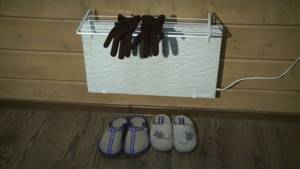
Special grid for drying things.
Pros of a halogen heater
It's amazing how many positive qualities this device has.
- Thanks to a special operating process, heating occurs instantly. It takes a few minutes, after which you will already feel the difference in degrees.
- As for the heating itself, it is uniformity. Some heaters are only capable of producing heat to the bottom of the room. Here the warm air mass is distributed equally over the entire area.
- Availability for purchase. One of the reasons for the high demand is the low cost, justified by the quality.
- It makes no sounds at all during operation. Noise-free guarantee.
- Light weight and compact. This means that you can place or hang the unit in any place, and it, in turn, will not take up much space in the apartment.
- Does not collect dust and therefore does not accumulate dirt.
- It is possible to use it not only in a closed area, but also in open areas.
- Easy to assemble and install.
- It does not dry out the air, so after work it will be easy to breathe and stay indoors.
Practical quartz heaters for the home: types
As you know, a quartz heater runs on electricity, which is why in recent years it has been gaining great popularity and love among the people. You can use such a heating element even in those parts of our country where gas is not laid.
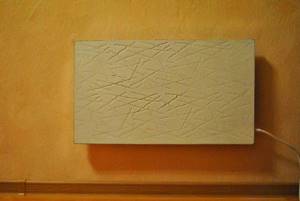
In fact, in the conditions of high competition in the modern market of equipment, in particular, heaters, there are many types of thermal elements:
- Quartz;
- Oily;
- Silicon;
- Tenovye (so-called heating elements);
- You can select a thermal convector and a ceramic heater.
We will consider only quartz heaters. Experts suggest distinguishing 2 main types of quartz heaters - a monolithic type, in appearance such a device is more reminiscent of the texture of a battery, but its thickness does not exceed 2.5 cm. The panels that make up the heater are themselves flat. Infrared type of heater - a distinctive feature of such heating elements is that such heaters have a glass tube. Before proceeding to a more detailed description of each type of heater, it is worth talking about why quartz heaters for heating homes and cottages were called quartz? It's actually quite simple.
For example, the tube of an infrared heater, which contains the heating element itself, is made of quartz sand, and monolithic electric heaters consist of sand, because it is part of the composition from which heater panels are cast in factories. That is why sometimes, instead of the usual phrase “quartz heaters,” you can come across another phrase: “sand heaters.”
Design and principle of operation
The equipment of the presented type is characterized by its appearance, which is a rectangular plate. The body of the heaters is made from quartz sand. The slab does not have a protective or reinforcing mesh inside. The devices are distinguished by a textured surface, which has an increased ability to absorb moisture.
It is noteworthy that, unlike any other devices for space heating, the body of a quartz heater can be painted in any color. This coloring will be absolutely safe for health and environmentally friendly. The popularity of quartz heaters is mainly explained by this property. They can be successfully integrated into any interior, or match the color to a ready-made room.

The relatively small size of the devices provides ample opportunities for choosing the installation location. The main thing is the need for a designated connection point to the electrical network. This is what a standard socket is used for. The back of the structure has a wire, the length of which is about one meter. The manufacturer does not supply the wire with a plug, so the user will have to purchase and install this element independently. The on/off button is located near where the wire exits.
Installation and mounting on the wall is carried out using special brackets. In stores you can find branded floor stands; they are sold as an additional option.
The housing has a heating element. They use a nichrome spiral. The effect of electric current heats the coil, which shares heat with the body. From the body, heat spreads into the surrounding atmosphere. Wire made of wear-resistant material allows heating throughout the day. This makes the Tepleko stove a full-fledged substitute for a centralized heating system.
The material from which the plate is made has a fairly high level of inertness. Therefore, the device heats up for a long time, however, it cools down for a long time. Maximum heating is achieved within half an hour. Even a switched-off heater, according to the factory instructions, is capable of giving off heat for another five hours.
2 Advantages and disadvantages of innovative batteries
MKTEN have become a real hit in recent years. At the same time, the consumer should know that a quartz heater has its pros and cons. The advantages of slabs with sand inside are as follows:
- Economical heating and high heat capacity. A device with standard dimensions heats up to maximum temperature, as mentioned, in 20–25 minutes. After this, it is disconnected from the power supply and gives off heat within one and a half to two hours. The heater cools down very slowly. In 120 seconds it loses 1 degree. This is due to the characteristics of quartz sand. It turns out that the stove heats the room for 1–1.5 hours without consuming expensive electricity.
- Durability of the device. The spiral element made of nickel and chromium is isolated from air ingress. Due to this, its service life is calculated for many years. And the quartz monolithic batteries themselves are very durable.
- The presence of a thermostat. This simple device significantly reduces energy costs and simplifies the battery operation process. You do not have to monitor the operation of the sand heating plate. Set the required temperature and enjoy the warmth in your home.
- Possibility of using the device daily in intensive mode. Quartz slabs can be used throughout the entire heating season without shutting down or carrying out any maintenance work.
Note that when installing several heaters, there is no need to purchase a control device for each battery. The plates are connected in series to one thermomechanism.
A quartz heater can be used in a wide variety of living spaces. MKTEN are ideal as backup heating for houses and apartments in which you live permanently. In the off-season, sand slabs will be literally indispensable. Devices with sand inside are also suitable for heating country cottages and real estate visited by their owners from time to time. In this case, you need to set a low temperature using the regulator (+10–12 °C) and be sure that the walls and ceilings in your home will not become damp during your absence.
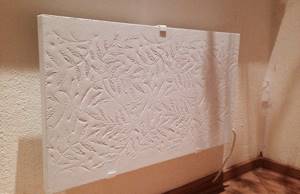
Quartz heater allows you to save heating costs
The new generation heater made of quartz sand has only one serious drawback. Its surface heats up to 95 degrees. Touching a stove at this temperature can result in severe burns. Therefore, if there are small children in the house, the batteries should be mounted higher from the floor. So far we have not been able to find any other disadvantages of monolithic quartz radiators.
Which one is better to choose and in what case
The presence of two heating devices with different structures makes it difficult to choose. Experts advise in this case to adhere to the following recommendations:
- Panels are better suited for constant heating of small rooms. But in this case, a thermostat is required. In its absence, the owners will face two surprises: high energy consumption and a home sauna when it gets warm outside;
- The room warms up faster with reflectors. Therefore, it is better to buy UFO heaters for the dacha in the autumn-winter season;
- open and semi-open spaces (veranda, gazebo) will be heated only by infrared devices;
- if you need to heat several rooms in an apartment or house with one device, infrared heaters are better suited - they are more mobile;
- you can quickly warm up a room or wall (instead of a heat gun) only using the wave method (“Ballu” BIH-LM-1.5);
- Regardless of what the manufacturer says, quartz heaters can only be used effectively in small rooms (up to 8 m2). Large rooms require a cascade, which means significant energy costs;
- with poorly insulated ceilings, the quartz panel will heat the sky;
- one device is not able to create a comfortable temperature in a country house, house or apartment when the frost is more than 5oC. Here you need either several units, or other types of heating to help;
- Before purchasing, you need to determine the power of the heater. Weak appliances will not heat, and powerful ones will constantly create a stuffy atmosphere;
- Having chosen a powerful unit, be sure to check the characteristics of the electrical wiring in the house or apartment. There is a high probability of failure of the entire system or blocking of the heater by control equipment;
- If you have limited finances, it is better to buy products from domestic manufacturers - they are cheaper. But you should remember about the huge number of fakes with poor quality - Chinese manufacturers are especially guilty;
- carbon heaters are superior to analogues with other heating elements only in service life. Here you need to make a choice: pay a lot of money and look at the heating battery for about half a century (you might get tired of it), or get by with relatively little money and replace the device when the family gets tired of it.
